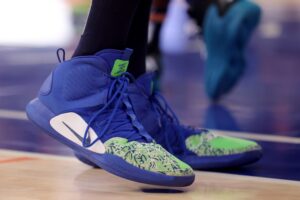In 1984, a revolutionary sneaker was born that would forever change the landscape of sports marketing and sneaker culture. The Air Jordan I, created for basketball phenom Michael Jordan, marked the beginning of one of the most iconic and enduring footwear lines in history. This article explores the origins, impact, and legacy of the first pair of Air Jordans.
The First Pair of Air Jordans: A Game-Changing Sneaker
The Birth of a Legend
In 1984, Michael Jordan was a rookie in the NBA, fresh out of the University of North Carolina. Nike, then a rising athletic company, saw immense potential in the young player and sought to sign him to an endorsement deal. At the time, Converse and Adidas were the dominant forces in basketball footwear, with Converse boasting endorsements from stars like Magic Johnson and Larry Bird.
Nike’s approach was revolutionary. Instead of simply offering Jordan a standard endorsement deal, they proposed something unprecedented: a signature line of shoes and apparel built around Jordan’s image. This strategy was a gamble, as Jordan was still an unproven rookie in the league.
Design and Development
The task of designing the first Air Jordan fell to Peter Moore, a lesser-known name compared to future Jordan designer Tinker Hatfield. Moore worked closely with Jordan to create a shoe that met the player’s specifications. Jordan wanted something eye-catching and low-cut, allowing him to feel the court beneath his feet.
The result was a shoe that broke conventions. The Air Jordan I featured a distinctive high-top design with a Nike Swoosh and a newly created “Air Jordan” wings logo. The shoe also incorporated Nike’s Air technology, with a pocket of compressed air in the sole to cushion impact.
The Controversial Colorway
One of the most iconic aspects of the original Air Jordan I was its colorway. Designed in the Chicago Bulls’ colors of red and black with white accents, the shoe immediately stood out on the court. However, this bold design choice led to controversy.
The NBA had a strict policy requiring shoes to be 51% white and in accordance with the team’s uniform. The Air Jordan I, with its predominantly red and black design, violated this rule. The league threatened to fine Jordan $5,000 per game for wearing the shoes.
Nike, seeing a marketing opportunity, agreed to pay the fines. They even created an advertisement around the controversy, stating, “On September 15th, Nike created a revolutionary new basketball shoe. On October 18th, the NBA threw them out of the game. Fortunately, the NBA can’t keep you from wearing them.” This rebellious narrative only added to the shoe’s appeal and mystique.
Launch and Initial Success
The Air Jordan I was officially launched on April 1, 1985, with a retail price of $64.99. Nike’s initial sales projections were modest – they hoped to sell 100,000 pairs in the first year. The actual results were beyond anyone’s wildest expectations.
In the first six weeks alone, Nike shipped 1.5 million pairs of Air Jordans. By the end of the year, sales had reached a staggering $126 million. This far surpassed Nike’s original four-year projection of $3 million in Air Jordan sales.
Cultural Impact
The Air Jordan I didn’t just change the sneaker industry; it became a cultural phenomenon. As rapper Nas stated in the documentary “The Last Dance,” “For a kid, it was almost like owning a lightsaber from Star Wars. You needed that shoe to be like him. It was more than a status symbol – you know that this guy was the guy.”
The shoe’s impact extended beyond basketball. It became a staple in hip-hop culture, further cementing its status as a must-have item. The Air Jordan I effectively bridged the gap between athletic performance and street style, a concept that continues to define sneaker culture today.
Legacy and Collectibility
Nearly four decades after its initial release, the Air Jordan I continues to be one of the most coveted sneakers in the world. Nike has capitalized on this enduring popularity by releasing numerous retro versions and colorways over the years.
Michael Jordan memorabilia is amongst the most sought-after in all of sports. A rare Michael Jordan photo, for instanced, fetched an unbelievable price tag just a few years ago. Michael Jordan playing cards are also insanely valued. Collecting of Air Jordans, particularly the original models, has reached unprecedented levels. In May 2020, a pair of game-worn, autographed 1985 Air Jordan 1s sold at auction for an astounding $672,000, setting a new world record for any footwear sold at auction.
The Jordan Brand Empire
The success of the Air Jordan I laid the foundation for what would become the Jordan Brand. In 1997, Nike established Jordan Brand as a separate subsidiary. Today, the brand encompasses a wide range of products beyond basketball shoes, including apparel, accessories, and collaborations with high-end fashion designers.
The financial impact of the Jordan Brand is staggering. In 2022 alone, it brought in $5.1 billion in revenue for Nike, with Michael Jordan himself reportedly earning between $150-256 million from the deal that year.
Conclusion
The first pair of Air Jordans represents more than just a successful product launch. It marked a paradigm shift in sports marketing, athlete endorsements, and sneaker culture. By creating a shoe that was as much a fashion statement as it was a performance product, Nike and Michael Jordan changed the game forever.
From its controversial beginnings to its current status as a highly sought-after collectible, the Air Jordan I has maintained its position at the forefront of sneaker culture for nearly four decades. Its influence extends far beyond the basketball court, touching fashion, music, and popular culture at large.
As we look back on the legacy of the first Air Jordans, it’s clear that they were more than just a pair of shoes. They were the beginning of a cultural movement that continues to shape the way we view the intersection of sports, fashion, and marketing to this day.






